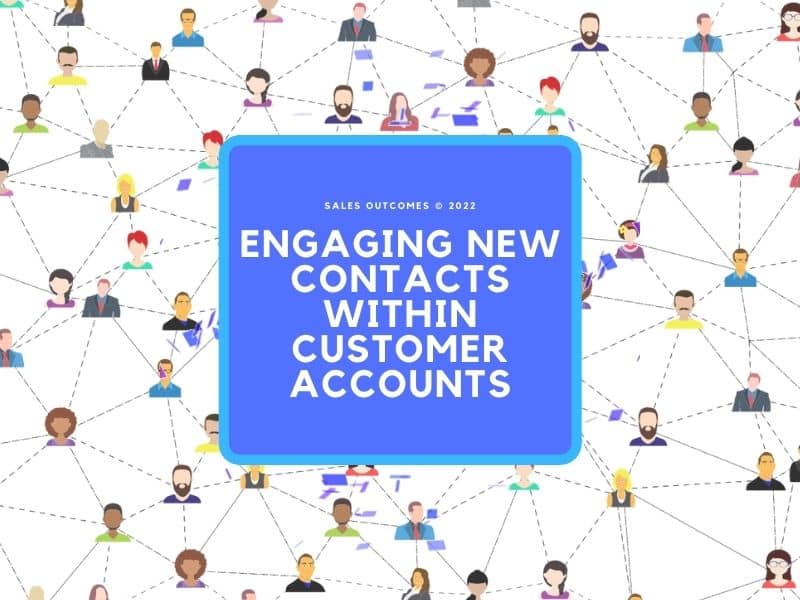Identifying and cultivating new connections within an existing account should be straightforward. Still, most account managers create a mental obstacle that leveraging existing relationships to meet new contacts may cause injury to the relationship.
Account Manager relationships are typically limited to one or two individuals within a customer account.
Requesting access or an introduction to a person’s boss or colleague requires a bit of finesse, but executed correctly can yield significant results.
Asking for introductions to other company contacts will “pressure test” your existing relationships. If you encounter an adverse reaction to your request, that might be all the more reason to get access to other contacts. If customer contacts aren’t comfortable introducing an account manager to others within the company, that’s a red flag.
If the account manager is not comfortable asking for an introduction, there alternative ways to expand relationship within the account.
Six Alternate Ways To Engage Additional Account Contacts
Six Alternate Ways To Engage Additional Account Contacts
Identifying and cultivating new connections within an existing account should be straightforward. Still, most account managers create a mental obstacle that leveraging existing relationships to meet new contacts may cause injury to the relationship.
Account Manager relationships are typically limited to one or two individuals within a customer account.
Requesting access or an introduction to a person’s boss or colleague requires a bit of finesse, but executed correctly can yield significant results.
Asking for introductions to other company contacts will “pressure test” your existing relationships. If you encounter an adverse reaction to your request, that might be all the more reason to get access to other contacts. If customer contacts aren’t comfortable introducing an account manager to others within the company, that’s a red flag.
If the account manager is not comfortable asking for an introduction, there alternative ways to expand relationship within the account.
Alternative Ways to Engage Additional Account Contacts
1. Build a Relationship Map
Either as part of an Account Plan or a stand-alone effort, build a map (org chart) of your existing contacts and others you desire to engage. Then apply attributes to these individuals to segment a friend or foe and how they might influence your growth and retention efforts. Don’t overcomplicate this step. Even a hand-drawn org chart is better than nothing.
2. Mine Internal Systems
In addition to your CRM, billing and order/contract management systems contain contact information to help identify individuals to add to the relationship map. Senior account contacts may be signing agreements, but often, they aren’t in the CRM.
3. Block 30 Minutes for Research
Manually search for contacts from LinkedIn, the company website, industry forums, and social media channels. Web searches using Boolean queries of company name and titles (e.g., VP, CXO) can provide articles that mention or quote company contacts to add to the relationship map. The chances are that you’ll also find relevant information to help you shape conversations.
4. Block An Additional 30 Minutes for Deeper LinkedIn Research
Once you’ve identified additional potential contacts from previous steps to add to your relation map, you should then utilize LinkedIn’s capabilities to determine 1st, 2nd, or 3rd level connections of the contacts you wish to engage. In addition to individuals within your network, you’ll regularly find individuals within your company connected to persons you need to engage. Prioritize connections to approach for support and add them to the relationship map. Most salespeople don’t apply this step consistently.
5. Develop Contact Engagement Options
There is more than one way to cook an egg, and there are at least as many contact engagement options. The options that best apply to your account depend on factors such as your tenure, the length of time they’ve been a customer, which contacts you need to engage with, and the overall relationship status between your firm and theirs, to name a few.
We suggest at least 3-5 contact engagement options. Examples include:
– LinkedIn direct message
– Personal 1:1 email
– Phone or email introduction from your LinkedIn network
– Phone or email introduction from your current account contacts
– Phone call directly to the contact
6. Enlist Others To Help
Improving your chances of succeeding with new contact engagement depends on your ability to identify, prioritize, and mobilize other individuals (internal and external) to help you. Enlisting senior leaders from your company, suppliers, consultants, and personal relationships increases the number of options you can consider. Doing this well can reduce the risk of injury to your current contact relationships.





